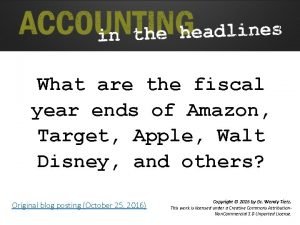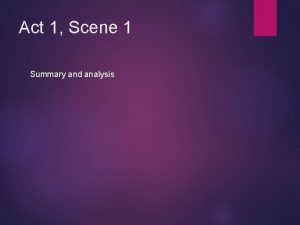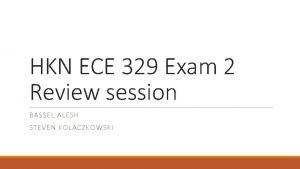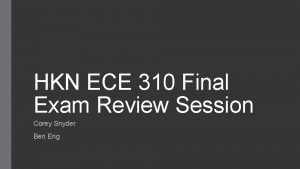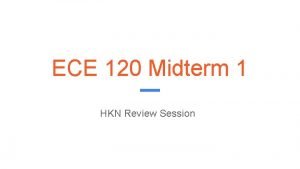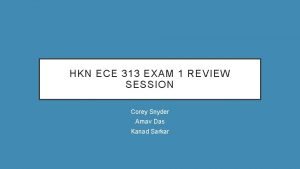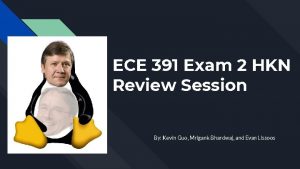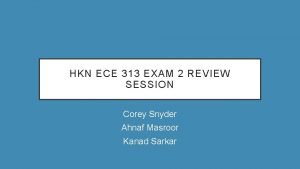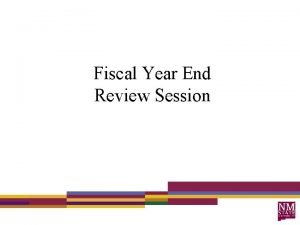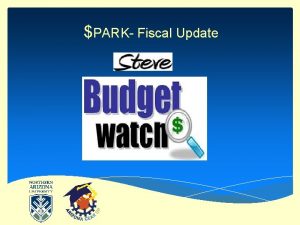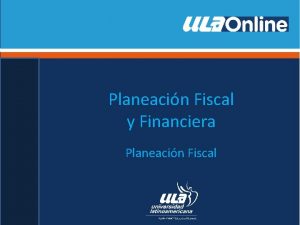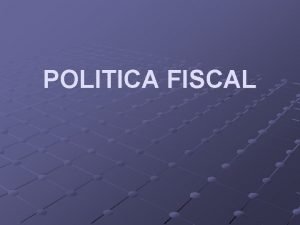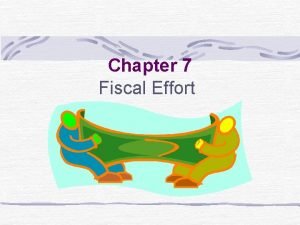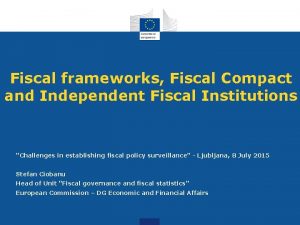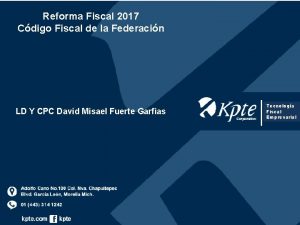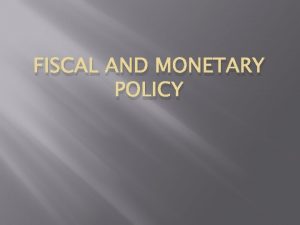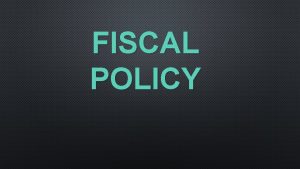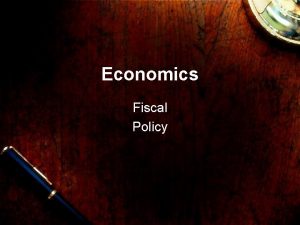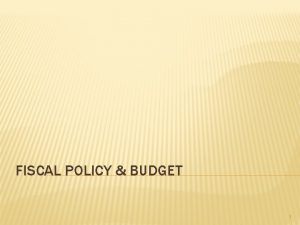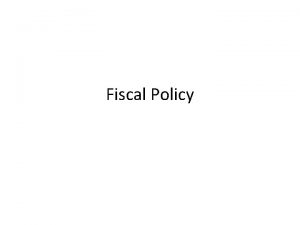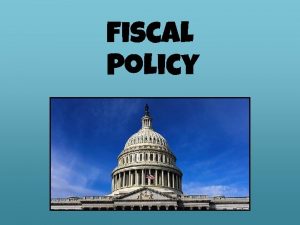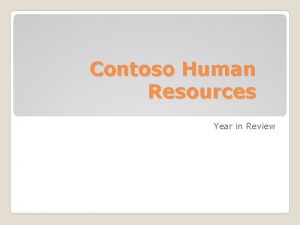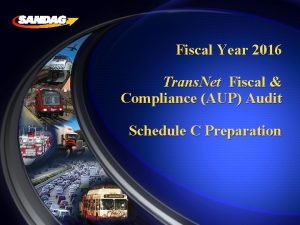REVIEW SESSION ONE When does the Fiscal Year





















- Slides: 21

REVIEW SESSION ONE • When does the Fiscal Year begin each year? • What are the five parts of a budget? • There are four funds. Name them and provide a brief explanation of each. • What is ADA and how do you calculate regular ADA and summer school ADA? • What is EP?

REVIEW CONTINUED • • Define Operating Levy Define Voluntary Rollback Unadjusted Tax Rate Adjusted Tax Rate

BUDGET TIMELINE • January: Meet with Board of Education and Adm. staff to establish priorities. You can actually begin this process as early as November if needed. • February: Preliminary budget estimates of revenues and expenditures should be prepared and discussed with the board of education. • March: Make any preliminary expenditure revisions based on discussions with BOE. Make sure to include insurance increases, retirement increase percentages and all other known increases in expenditures.

BUDGET TIMELINE • April: Update projections, if needed, and present to the board of education. • Should work with board to make sure have established tentative tax levy for next fiscal year. • Begin working with staff and board on salary and benefits.

BUDGET TIMELINE • May/June: Complete end of year reports. • June: Determine fund balances (ASBR). ASBR must be submitted by midnight, August 15 to DESE (Finance Section). • Complete discussions on tax levy • New budget must be adopted no later than June 30 th. Many districts adopt the existing budget for operating purposes until all revenues and expenditures are known.

BUDGET TIMELINE • July/August: The statutory and constitutional compliance checks for the district’s tax rate ceiling for operations and the establishment of the debt service levy need to be completed (State Auditors Form). Board must have tax rate hearing and adopt a tax rate, usually at August meeting. • State Auditors forms need to be completed and filed with the County Clerk of each county served by your district. This needs to be completed no later than September 1 st.

REVENUE (Refer to your budget) • Local Revenue (5100): Major sources of local revenue are from tax collections (current and delinquent), Prop C. During good economic times, interest can also be a good source of local revenue. • County Revenue (5200): Major source Railroad and Utilities receipts. Another good source is fines and forfeitures.

REVENUE • STATE (5300): Largest state revenue is “Basic Formula” money. This amount varies from school to school based on a variety of variables. Other major state revenues are Classroom Trust Fund, Career Ladder, Transportation (this funding categorical continues to be reduced). • Federal (5400): Major sources are from Title funds, IDEA, Food Service.

REVENUE • There are other sources of revenue such as Tuition from other districts, sale of real estate, sale of buses, etc.

REVENUE PROJECTIONS • When doing preliminary work on a budget you should begin by calculating revenues. • ALWAYS, have a copy of your current budget at hand when working on budget projections. You need to know if there is a major difference from year to year and you need to know WHY there is a major difference.

REVENUE PROJECTIONS • To project local revenue you will need to know the amount of your proposed tax levy, anticipated collection rate, and your assessed valuation. • To estimate your assessed valuation you may want to contact your County Assessor.

REVENUE PROJECTIONS • Example: Project a $3. 10 Operating levy and a $0. 86 debt service levy =$3. 96 total levy. • Multiply $3. 96 x Assessed Valuation then divided this number by 100 and multiply by your collection rate. • Complete: Levy of $4. 05, Assessed Valuation of 80, 000 and a collection rate of 90%.

REVENUE PROJECTIONS • Your total anticipated local revenue should be $2, 916, 000. This is a projection based on the best information available. • How do you determine your collection rate?

REVENUE PROJECTIONS • Proposition C Revenue: Each month DESE sends financial information to districts which includes your monthly revenue from state and federal dollars, and they also include information about projections for things such as Prop C payments, which is based on “EP”. This is also available to review on the DESE web site. • You simply multiply the dollar amount per EP projected by DESE by your projected EP.

REVENUE PROJECTIONS • County Revenue: The major source of county revenue will be Railroad and Utilities. This is an extremely complicated calculation, one most do not attempt. Districts receive a one-time payment in January. Amount based somewhat on your levy, number of students, and bond issues in all districts in the county. Generally, the amount will be similar to the prior year. • Fines/Forfeitures: It is impossible to calculate this amount. Again, generally based on the prior year.

REVENUE PROJECTIONS • State Revenues: The major state funds will come through SB 287 -School Foundation Formula. This replaced SB 380 and is being phased in over a seven year period. State aid is provided to districts on a monthly basis. Each district will receive dollars based on several different variables. This will be discussed when we review the formula calculation. • Classroom Trust Fund: These dollars are allocated as part of the formula and can be placed in any Fund at the discretion of the board.

REVENUE PROJECTIONS • The remaining large state appropriation is for transportation. Again, there is a formula for determining the amount districts receive and it is based on number of students who ride the bus and the total eligible miles traveled. • Originally, the state planned to fund 75% of allowable cost, however, that percentage was reduced to about 47% last year, and will continue to fall until the state appropriates more money for transportation.

REVENUE PROJECTIONS • Federal: It is difficult to make preliminary revenue projections for federal programs as the information constantly changes and is not known until very late in the year. Work closely with the Director of Federal Programs and keep as current as possible. • For all revenue projections, it is good practice to review the three year comparison data in the prior year budget.

REVENUE • State Auditors Calculation: Review state auditors tax levy calculation form. • Estimate of Required Local Taxes form for County Clerk. This form must be submitted prior to September 1 st. The County Clerk will then file this with the State Auditors Office.

REVENUE • Review SB 287 Foundation Formula. • Major implications on formula: 1. ADA 2. Dollar Value Modifier 3. Free/Reduced numbers 4. Special Education numbers 5. Other

Session Three • Our next session will focus on Expenditures and the Annual Secretary of the Board Report (ASBR). • We will also discuss how to evaluate a budget and Fund Transfers
 Amazon fiscal year end
Amazon fiscal year end Year up info session
Year up info session Act 1 scene 1 hamlet
Act 1 scene 1 hamlet Hkn review session
Hkn review session Ece 310
Ece 310 Ece 120 wiki
Ece 120 wiki Ece 313 uiuc
Ece 313 uiuc Hkn review session
Hkn review session Ece 391
Ece 391 Corey snyder uiuc
Corey snyder uiuc Year 6 leavers poem from teacher
Year 6 leavers poem from teacher One god one empire one religion
One god one empire one religion Little dog run
Little dog run One king one law one faith
One king one law one faith One god one empire one emperor
One god one empire one emperor One ford behaviors
One ford behaviors See one do one teach one
See one do one teach one See one, do one, teach one
See one, do one, teach one One face one voice one habit and two persons
One face one voice one habit and two persons See one do one teach one
See one do one teach one One vision one identity one community
One vision one identity one community One vision one identity one community
One vision one identity one community
